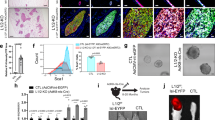Abstract
The Wnt signal transduction pathway has been implicated in mammary tumorigenesis in the mouse. β-catenin, a key downstream effector of this pathway interacts with and thus activates the Tcf/Lef family of transcription factors. Elevated levels of β-catenin have been found in many human tumors, notably colon carcinomas. Recently, elevated levels of β-catenin have been associated with poor prognosis in human adenocarcinoma of the breast. In order to assess the possible role of β-catenin in mammary carcinoma, we have created transgenic mice bearing the MMTV–LTR driving an activated form of β-catenin. These mice develop mammary gland hyperplasia and mammary adenocarcinoma, a phenotype very similar to that of transgenic mice expressing an MMTV-driven Wnt gene. Indeed, the histopathology of the mammary tumors in Wnt-mediated adenocarcinoma is identical to that observed in our β-catenin-mediated disease model. Furthermore, putative β-catenin transcriptional targets, cyclin D1 and c-myc, are elevated in β-catenin-mediated mammary tumors and cell lines. These observations support the notion that the oncogenic Wnt pathway operates via β-catenin and its targets in the context of mammary hyperplasia and carcinoma.
This is a preview of subscription content, access via your institution
Access options
Subscribe to this journal
Receive 50 print issues and online access
$259.00 per year
only $5.18 per issue
Buy this article
- Purchase on Springer Link
- Instant access to full article PDF
Prices may be subject to local taxes which are calculated during checkout






Similar content being viewed by others
References
Barth AI, Pollack AL, Altschuler Y, Mostov KE, Nelson WJ . 1997 J. Cell. Biol. 136: 693–706
Brown AM, Wildin RS, Prendergast TJ, Varmus HE . 1986 Cell 46: 1001–1009
Bullions LC, Levine AJ . 1998 Curr. Opin. Oncol. 10: 81–87
Gat U, DasGupta R, Degenstein L, Fuchs E . 1998 Cell 95: 605–614
Haertel-Wiesmann M, Liang Y, Fantl WJ, Williams LT . 2000 J. Biol. Chem. 275: 32046–32051
Harada N, Tamai Y, Ishikawa T, Sauer B, Takaku K, Oshima M, Taketo MM . 1999 EMBO J. 18: 5931–5942
He TC, Sparks AB, Rago C, Hermeking H, Zawel L, da Costa LT, Morin PJ, Vogelstein B, Kinzler KW . 1998 Science 281: 1509–1512
Henderson BR . 2000 Nat. Cell. Biol. 2: 653–660
Hsu SC, Galceran J, Grosschedl R . 1998 Mol. Cell. Biol. 18: 4807–4818
Kinzler KW, Vogelstein B . 1996 Cell 87: 159–170
Kolligs FT, Hu G, Dang CV, Fearon ER . 1999 Mol. Cell. Biol. 19: 5696–5706
Lane TF, Leder P . 1997 Oncogene 15: 2133–2144
Lin SY, Xia W, Wang JC, Kwong KY, Spohn B, Wen Y, Pestell RG, Hung MC . 2000 Proc. Natl. Acad. Sci. USA 97: 4262–4266
Morin PJ, Sparks AB, Korinek V, Barker N, Clevers H, Vogelstein B, Kinzler KW . 1997 Science 275: 1787–1790
Moser AR, Mattes EM, Dove WF, Lindstrom MJ, Haag JD, Gould MN . 1993 Proc. Natl. Acad. Sci. USA 90: 8977–8981
Munemitsu S, Albert I, Rubinfeld B, Polakis P . 1996 Mol. Cell. Biol. 16: 4088–4094
Neufeld KL, Nix DA, Bogerd H, Kang Y, Beckerle MC, Cullen BR, White RL . 2000 Proc. Natl. Acad. Sci. USA 97: 12085–12090
Orsulic S, Peifer M . 1996 J. Cell. Biol. 134: 1283–1300
Pennica D, Swanson TA, Welsh JW, Roy MA, Lawrence DA, Lee J, Brush J, Taneyhill LA, Deuel B, Lew M, Watanabe C, Cohen RL, Melhem MF, Finley GG, Quirke P, Goddard AD, Hillan KJ, Gurney AL, Botstein D, Levine AJ . 1998 Proc. Natl. Acad. Sci. USA 95: 14717–14722
Polakis P . 1999 Curr. Opin. Genet. Dev. 9: 15–21
Polakis P . 2000 Genes Dev. 14: 1837–1851
Rosin-Arbesfeld R, Townsley F, Bienz M . 2000 Nature 406: 1009–1012
Smith R, Peters G, Dickson C . 1995 Genomics 25: 85–92
Shtutman M, Zhurinsky J, Simcha I, Albanese C, D'Amico M, Pestell R, Ben-Zeev A . 1999 Proc. Natl. Acad. Sci. USA 96: 5522–5527
Tetsu O, McCormick F . 1999 Nature 398: 422–426
Tsukamoto AS, Grosschedl R, Guzman RC, Parslow T, Varmus HE . 1988 Cell 55: 619–625
van de Wetering M, Cavallo R, Dooijes D, van Beest M, van Es J, Loureiro J, Ypma A, Hursh D, Jones T, Bejsovec A, Peifer M, Mortin M, Clevers H . 1997 Cell 88: 789–799
Wong GT, Gavin BJ, McMahon AP . 1994 Mol. Cell. Biol. 14: 6278–6286
Wong MH, Rubinfeld B, Gordon JI . 1998 J. Cell. Biol. 141: 765–777
Xu L, Corcoran RB, Welsh JW, Pennica D, Levine AJ . 2000 Genes Dev. 14: 585–595
Ziemer LT, Pennica D, Levine AJ . 2001 Mol. Cell. Biol. 21: 562–574
Acknowledgements
We thank Anne Harrington for technical assistance in generating the transgenic mice. JS Michaelson is supported by a Breast Cancer Research Fellowship from the Department of Defense.
Author information
Authors and Affiliations
Rights and permissions
About this article
Cite this article
Michaelson, J., Leder, P. β-catenin is a downstream effector of Wnt-mediated tumorigenesis in the mammary gland. Oncogene 20, 5093–5099 (2001). https://doi.org/10.1038/sj.onc.1204586
Received:
Revised:
Accepted:
Published:
Issue Date:
DOI: https://doi.org/10.1038/sj.onc.1204586
Keywords
This article is cited by
-
In Vitro Anti-cancer Effect of Crataegus oxyacantha Berry Extract on Hormone Receptor Positive and Triple Negative Breast Cancers via Regulation of Canonical Wnt Signaling Pathway
Applied Biochemistry and Biotechnology (2023)
-
Elevated EDAR signalling promotes mammary gland tumourigenesis with squamous metaplasia
Oncogene (2022)
-
MORC2/β-catenin signaling axis promotes proliferation and migration of breast cancer cells
Medical Oncology (2022)
-
Exercise intervention lowers aberrant serum WISP-1 levels with insulin resistance in breast cancer survivors: a randomized controlled trial
Scientific Reports (2020)
-
MGAT1 is a novel transcriptional target of Wnt/β-catenin signaling pathway
BMC Cancer (2018)



